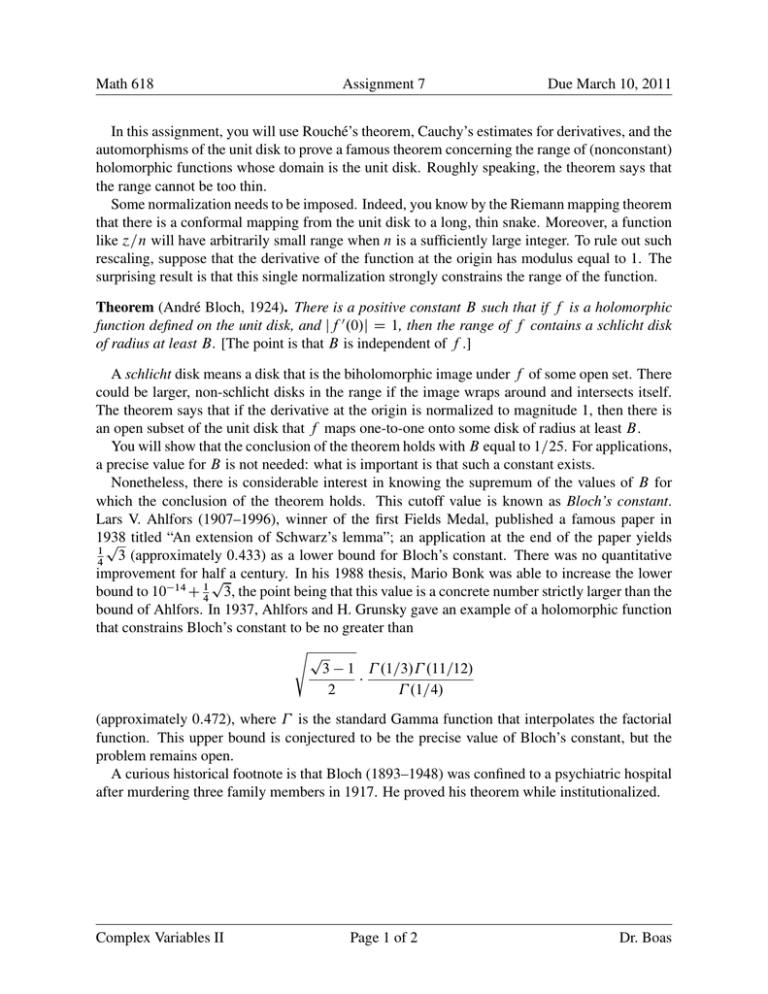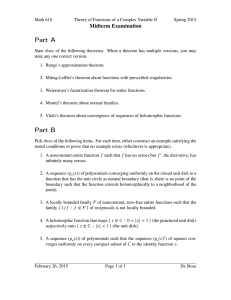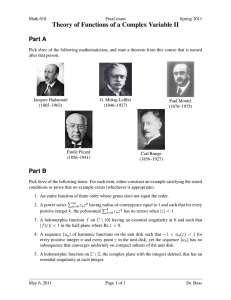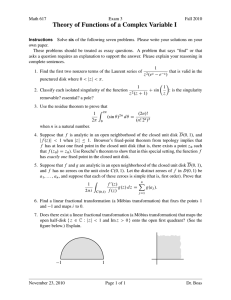Math 618 Assignment 7 Due March 10, 2011
advertisement

Math 618 Assignment 7 Due March 10, 2011 In this assignment, you will use Rouché’s theorem, Cauchy’s estimates for derivatives, and the automorphisms of the unit disk to prove a famous theorem concerning the range of (nonconstant) holomorphic functions whose domain is the unit disk. Roughly speaking, the theorem says that the range cannot be too thin. Some normalization needs to be imposed. Indeed, you know by the Riemann mapping theorem that there is a conformal mapping from the unit disk to a long, thin snake. Moreover, a function like ´=n will have arbitrarily small range when n is a sufficiently large integer. To rule out such rescaling, suppose that the derivative of the function at the origin has modulus equal to 1. The surprising result is that this single normalization strongly constrains the range of the function. Theorem (André Bloch, 1924). There is a positive constant B such that if f is a holomorphic function defined on the unit disk, and jf 0 .0/j D 1, then the range of f contains a schlicht disk of radius at least B. [The point is that B is independent of f .] A schlicht disk means a disk that is the biholomorphic image under f of some open set. There could be larger, non-schlicht disks in the range if the image wraps around and intersects itself. The theorem says that if the derivative at the origin is normalized to magnitude 1, then there is an open subset of the unit disk that f maps one-to-one onto some disk of radius at least B. You will show that the conclusion of the theorem holds with B equal to 1=25. For applications, a precise value for B is not needed: what is important is that such a constant exists. Nonetheless, there is considerable interest in knowing the supremum of the values of B for which the conclusion of the theorem holds. This cutoff value is known as Bloch’s constant. Lars V. Ahlfors (1907–1996), winner of the first Fields Medal, published a famous paper in 1938 p titled “An extension of Schwarz’s lemma”; an application at the end of the paper yields 1 3 (approximately 0:433) as a lower bound for Bloch’s constant. There was no quantitative 4 improvement for half p a century. In his 1988 thesis, Mario Bonk was able to increase the lower bound to 10 14 C 14 3, the point being that this value is a concrete number strictly larger than the bound of Ahlfors. In 1937, Ahlfors and H. Grunsky gave an example of a holomorphic function that constrains Bloch’s constant to be no greater than sp 3 1 .1=3/ .11=12/ 2 .1=4/ (approximately 0:472), where is the standard Gamma function that interpolates the factorial function. This upper bound is conjectured to be the precise value of Bloch’s constant, but the problem remains open. A curious historical footnote is that Bloch (1893–1948) was confined to a psychiatric hospital after murdering three family members in 1917. He proved his theorem while institutionalized. Complex Variables II Page 1 of 2 Dr. Boas Math 618 Assignment 7 Due March 10, 2011 1. To get started with the proof, suppose that f is holomorphic in a neighborhood of the closed unit disk. (Then f and f 0 will be bounded in the unit disk.) You will remove this special hypothesis at the end. If ' is an automorphism of the unit disk, then f and f ı ' have the same range. Show that among such composite functions, there is one that maximizes the modulus of the derivative at the origin. Moreover, that maximal value is supj´j<1 jf 0 .´/j.1 j´j2 /, which is no smaller than 1. You will need to use the explicit form of automorphisms of the unit disk. 2. Show that supj´j<1 jg 0 .´/j.1 preceding part. 3. Let h.´/ denote fg.´/ and h0 .0/ D 1.) Then j´j2 / D jg 0 .0/j, where g is the extremal function from the g.0/g=g 0 .0/. (The point of defining h this way is that h.0/ D 0 jh0 .´/j 1 1 j´j2 when j´j < 1. Why does it suffice to show that the range of h contains a schlicht disk of radius independent of h? p 4. Show that if j´j 1= 2, then jh0 .´/j 2. 5. By integrating the derivative, show that if j´j 1=2, then jh.´/j 1. 6. Deduce from Cauchy’s estimates for derivatives that the nth Maclaurin coefficient of h has modulus no greater than 2n . 7. By estimating the Maclaurin series of h, show that if j´j 1=8, then jh.´/ ´j 1=12. 8. Deduce from Rouché’s theorem that if jwj < 1=24, then there is exactly one ´ such that j´j < 1=8 and h.´/ D w. 9. Remove the special assumption that f is holomorphic in a neighborhood of the closed unit disk by considering the function r 1 f .r´/ for r slightly less than 1, and put everything together to deduce that the conclusion of Bloch’s theorem holds with B D 1=25. Complex Variables II Page 2 of 2 Dr. Boas







